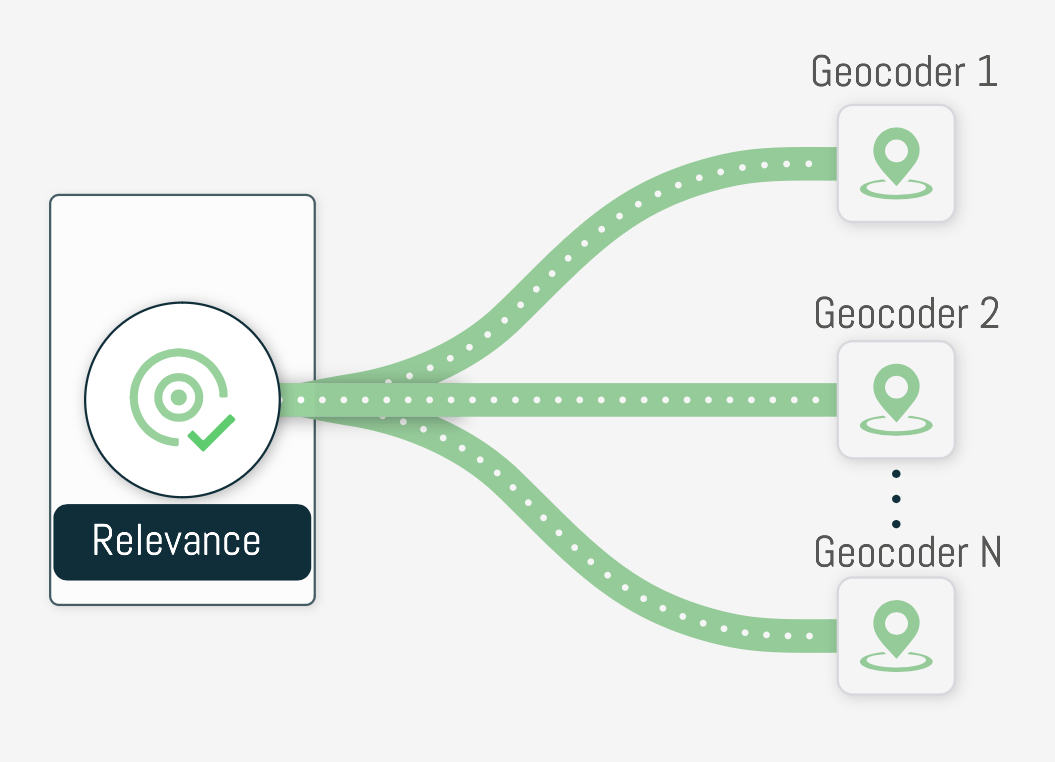Relevance Validation
Advanced address matching for precise, efficient last-mile deliveries, enhancing customer satisfaction and operational effectiveness.

Table of Contents
What is Relevance Validation?
Geocoding relevance validation is a method used to compare and validate addresses by analyzing the similarity between the ‘requested’ address—a standardized format of the address sent for geocoding—and multiple ‘result’ addresses provided by different geocoding services. This comparison is not a simple apples-to-apples look but a nuanced approach that recognizes the complexity of address components and their varying degrees of importance.
The Value of the Process
The relevance validation process is not just about finding a match but finding the best match. It sifts through the noise of near-misses and errors to identify the geocoding result that most accurately reflects the real-world location. This is critical for businesses that rely on precise location data for deliveries, service provision, and logistics. An incorrect address can lead to failed deliveries, lost time, and dissatisfied customers.
Moreover, this process offers an additional layer of quality assurance. By validating the results against a normalized address, the system ensures consistency and accuracy in the addresses used across different platforms and services. This uniformity is essential for businesses that operate at scale, where discrepancies in address data can lead to systemic inefficiencies and increased operational costs.

The Mechanism of Geocoding Relevance Validation
The Art of Finding the Perfect Address Match
The magic of geocoding relevance validation lies in its meticulous approach, similar to an artisan crafting a masterpiece. The process begins with what we call the normalized address. This is the address in its most pristine form, free from the chaos of everyday variations and errors. It’s the clean slate from which we start our journey and the result of the normalization process.
Once we have this polished address, we enter the realm of degradative comparison. Imagine this as a sliding scale of accuracy. We compare the normalized address against a range of potential matches from various geocoders. Each potential match is like a different lens through which we view the address, some clearer, some more distorted.
As we slide down this scale, the comparison becomes less about exact matches and more about general similarities. It’s a careful balance between being too rigid and too lenient. We examine each component of the address – the street, the city, the zip code. Each piece is scrutinized to ensure it fits into the puzzle perfectly.
This component analysis is where the true skill of geocoding relevance validation shines. It’s not just about finding a match; it’s about finding the best match. It’s a process that requires both precision and a deep understanding of how addresses work in the real world.
As we conclude this phase, we’ve not only found a match for our address but ensured that it’s the most accurate, the most true to life. This is the cornerstone of successful deliveries – knowing that the address on the package is the address where it needs to be.
Challenges and Limitations
Navigating the Inevitable Obstacles
The world of geocoding relevance validation, though advanced, faces its share of challenges. One major hurdle is the diverse address formats seen globally. Each country, and often regions within, presents a unique addressing style. This diversity demands a system that’s both flexible and astute, able to decode a myriad of formats into a standardized form.
Local addressing nuances add another layer of complexity. The same street may have multiple names: an official one and a local moniker. The system must be sharp enough to recognize and reconcile such discrepancies, ensuring accurate delivery despite these idiosyncrasies.
Finally, the limitations of technology and data quality can hinder the process. In areas with limited or outdated address information, achieving the desired accuracy is a significant challenge. The quality of geocoding relevance validation is directly tied to the data it processes and the technology it employs. These constraints needs continuous adaptation and improvement in methodologies and tools.
Coming Up: The Backbone of Efficient Address Recall
Speeding up the process for next time
As we conclude our exploration of geocoding relevance validation, we turn our gaze to the next critical component in the address intelligence process: caching. Caching represents the evolution of address intelligence, focusing on storing and swiftly retrieving the most accurate address data.
FAQ
It streamlines the process by ensuring deliveries are sent to the correct address the first time, reducing delays caused by address errors.
Yes, it’s included in AddressHub and designed to integrate with various systems, enhancing the accuracy of address data used in your current delivery operations.
By reducing delivery errors and improving route efficiency, companies often see significant cost savings in logistics and customer service.
It utilizes multiple geocoding sources to maximize the chances of accurately pinpointing locations, even in less-mapped areas.
Yes, it’s designed to be adaptable and update its database to reflect changes in address formats and new geographic developments.
Gain a Competitive Edge with Intelligent Handling of Address Data, Ensuring On-Time, Every Time Deliveries with High Accuracy and Relevance.

© 2025 AddressHub LLC. All rights reserved

